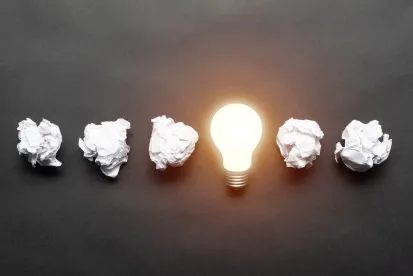Key Takeaways:
-
What Happened: DOE finalized rules to apply the 45 lumens per watt “backstop” efficiency standard to general service lamps and to include five categories of specialty incandescent lamps, incandescent reflector lamps, and a variety of decorative lamps under the definition of “general service lamps.” These rules effectively prohibit the manufacture, distribution, and sale of most incandescent and halogen lamps in the United States.
-
Who’s Impacted: Manufacturers, importers, distributors, and retailers of general service lamps.
-
What Should They Consider Doing in Response: Assess product lines, supply chains, and inventories to ensure compliance with the new GSL standards. Import of non-compliant lamps will be permitted until January 2023, and their retail sale will be permitted until July 2023.
The U.S. Department of Energy (DOE) has finalized new, more stringent efficiency requirements for most lightbulbs on the market. In August 2021, DOE proposed reinstating the Obama Administration’s revised definitions of general service lamp (GSL), general service incandescent lamp (GSIL), and other supplemental definitions that imposed federal efficiency standards on a wide array of lamps. In December 2021, DOE proposed to apply a more stringent 45 lumens per watt (lm/W) standard to all of these lamps, a change with major implications for lamp manufacturers, distributors, and retailers across the United States. These rules are now final and will be effective, respectively, 60 and 75 days after their publication in the Federal Register. However, full enforcement will not begin until January 2023 (manufacture and import) and July 2023 (retail and distribution).
Background
With the Energy Independence and Security Act of 2007 (EISA), Congress directed DOE to initiate rulemaking procedures to determine whether efficiency standards for GSLs should be amended to be “more stringent” than those that currently apply to fluorescent lamps and incandescent reflector lamps and whether existing exemptions for “certain incandescent lamps should be maintained or discontinued.”
The EISA sought to prod DOE into moving quickly to establish GSL/GSIL efficiency standards. First, Congress provided that if DOE “determines that the standards in effect for general service incandescent lamps should be amended, the Secretary shall publish a final rule not later than” January 1, 2017. Second, Congress included a “backstop” measure: if the Secretary of Energy “fails to complete a rulemaking” as directed, “the Secretary shall prohibit the sale of any general service lamp that does not meet a minimum efficacy standard of 45 lumens per watt,” effective January 1, 2020. The 45-lumen standard is generally understood to be unachievable for many incandescents, and would, therefore, hasten an ongoing transition to LED lamps. The backstop standard is also unusual to the extent that it would apply as a prohibition on sale, while most other appliance and equipment standards enforced by DOE apply to import and manufacture, rather than sale. As a result, the backstop not only impacts lamp manufacturers, but also the retailers who market such lamps.
In September 2019, the Trump Administration rescinded the Obama Administration’s revised lamp definitions and concluded that the backstop would not take effect the following January because DOE had not “determine[d]” that amended definitions were necessary. Following opportunities for public comment, the Biden Administration proposed to reinstate the Obama DOE definitions in August 2021, and in December 2021 proposed to apply the 45 lm/W backstop standard to all federally regulated GSLs/GSILs because DOE has “failed to complete a rulemaking” under the EISA.
New Definitions, Stricter Standards
Under the newly finalized rules, “general service lamps” will include not only pear-shaped A-type bulbs, but also five categories of specialty incandescent lamps (rough service lamps, shatter-resistant lamps, 3-way incandescent lamps, high lumen incandescent lamps, and vibration service lamps), incandescent reflector lamps, and a variety of decorative lamps (T-Shape, B, BA, CA, F, G16-1/2, G25, G30, S, M-14 of 40W or less, and candelabra base lamps). All such lamps will be required to meet the 45 lm/W .
Approximately 30 percent of light bulbs sold across the United States in 2020 were incandescent or halogen incandescent lamps. Almost all such lamps would fail to meet the statutory 45 lm/W backstop standard. Because most LED lamps can meet the 45 lm/W standard, DOE’s actions are expected to accelerate a transition to LEDs.
DOE’s final rules also sidestep an ongoing dispute between the Department and several states that had adopted the backstop standard when DOE declined to do so. DOE has previously asserted that such state standards were federally preempted, and reasserts that under EPCA, the federal standard preempts state standards “for the products that are the subject of [these] final rule[s].” However, DOE notes that states may petition DOE for exemption from such preemption as permitted under EPCA.
Phased Enforcement
The 45 lm/W standard will be implemented in phases, as set out in a new enforcement policy.
DOE intends to gradually enforce new rules against lamp manufacturers and importers. Beginning on the backstop rule’s effective date (75 days from its publication in the Federal Register) through August 2022, DOE intends to have an enforcement leniency period to account for transition lead times (however, the Department notes that it may still enforce the rules during this period against “egregious violations, repeat violations, or as circumstances dictate”). DOE plans to issue warning notices to manufacturers and importers beginning in September 2022, to pursue reduced penalties beginning in November 2022, and to begin full enforcement in January 2023.
DOE also intends to gradually enforce the new rules against lamp distributors and retailers, and to do so with several months’ delay after manufacturer enforcement to allow for the transition of existing inventories. DOE plans to issue warning notices to distributors and retailers beginning in January 2023, to pursue reduced penalties beginning in March 2023, and to begin full enforcement in July 2023. DOE notes that “very small retailers should contact DOE for additional flexibilities regarding their inventory.”
DOE will host a General Service Lamps Enforcement Policy Webinar on Wednesday, May 4, 2022, from 2:00–3:30 PM. Those interested in joining should email appliancestandardsquestions@ee.doe.gov to request a link.






 />i
/>i

